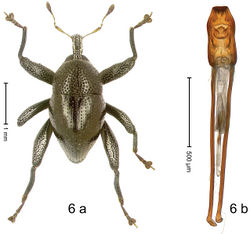Trigonopterus ancoruncus
| Notice: | This page is derived from the original publication listed below, whose author(s) should always be credited. Further contributors may edit and improve the content of this page and, consequently, need to be credited as well (see page history). Any assessment of factual correctness requires a careful review of the original article as well as of subsequent contributions.
If you are uncertain whether your planned contribution is correct or not, we suggest that you use the associated discussion page instead of editing the page directly. This page should be cited as follows (rationale):
Citation formats to copy and paste
BibTeX: @article{Riedel2013ZooKeys280, RIS/ Endnote: TY - JOUR Wikipedia/ Citizendium: <ref name="Riedel2013ZooKeys280">{{Citation See also the citation download page at the journal. |
Ordo: Coleoptera
Familia: Curculionidae
Genus: Trigonopterus
Name
Trigonopterus ancoruncus Riedel sp. n. – Wikispecies link – ZooBank link – Pensoft Profile
Diagnostic description
Holotype, male (Fig. 6a). Length 2.49 mm. Color black; antenna and tarsi ferruginous. Body subovate; in dorsal aspect and in profile with distinct constriction between pronotum and elytron. Eyes large. Rostrum medially with two rows of course squamiferous punctures; pair of lateral furrows with row of larger overlapping almond-shaped white scales. Pronotum densely punctate; dorsally punctures containing inconspicuous setae, anterolaterally with scattered white scales. Elytra with striae distinct; intervals flat, subglabrous, each with one row of minute punctures. Femora ventrally with acute tooth. Mesofemur and metafemur dorsally sparsely squamose with white scales. Metafemur subapically with stridulatory patch. Metatibia at middle curved ventrad, subapically with brush of long setae; uncus hook-like extended, curved ventrobasad. Aedeagus (Fig. 6b) with apodemes 2.5 × as long as body; sides of body weakly bisinuate, converging; apex extended, pointed, markedly curved ventrad, sinuate in profile; transfer apparatus flagelliform, subequal to body of aedeagus; ductus ejaculatorius without bulbus.
Material examined
Holotype (SMNK): ARC1115 (EMBL # HE615744), PAPUA NEW GUINEA, Simbu Prov., Karimui Dist., Haia, Supa, S06°40.078', E145°03.207' to S06°39.609', E145°03.012', 1220–1450 m, 02-X-2009.
Distribution
Simbu Prov. (Haia). Elevation: ca. 1220–1450 m.
Biology
Collected by beating foliage in montane forest.
Etymology
This epithet is based on a combination of the Latin nouns ancora (anchor) and uncus (hook; tibial uncus) in apposition and refers to the species´ remarkable metatibia.
Notes
Trigonopterus ancoruncus Riedel, sp. n. was coded as “Trigonopterus sp. 78” by Tänzler et al. (2012)[1].
Original Description
- Riedel, A; Sagata, K; Surbakti, S; Rene Tänzler, ; Michael Balke, ; 2013: One hundred and one new species of Trigonopterus weevils from New Guinea ZooKeys, 280: 1-150. doi
Other References
- ↑ Tänzler R, Sagata K, Surbakti S, Balke M, Riedel A (2012) DNA barcoding for community ecology - how to tackle a hyperdiverse, mostly undescribed Melanesian fauna. PLoS ONE 7 (1): e28832. doi: 10.1371/journal.pone.0028832
Images
|
